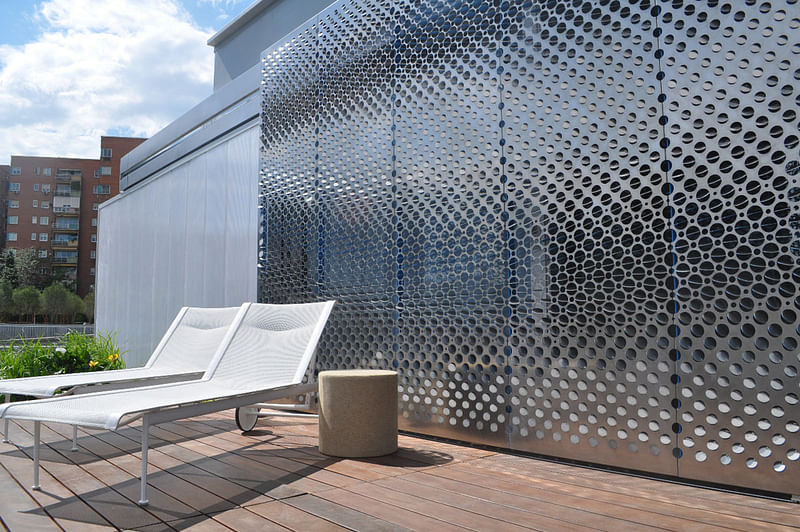Virginia Tech's Lumenhaus Victorious in the 2010 Solar Decathlon Europe
By Bustler Editors|
Friday, Aug 6, 2010

Related
Virginia Tech's small house made a bold impression at the Solar Decathlon Europe in Madrid, Spain.
Press Release Follows...
A small house has made a big impression through its integration of design and technology. Virginia Tech’s Lumenhaus went to Madrid, Spain, with its pavilion-style architecture seamlessly melding the interior and exterior spaces, and was victorious against 16 international research universities in the 2010 Solar Decathlon Europe.
The 800-square-foot solar home feels large because spatial effects and comfort were considered as the project was developed. Lumenhaus uses sun, shade, light, natural ventilation, and water to integrate the interior with the exterior by using multiple layers to encase the home for interior environmental control.
“Lumenhaus won because it’s not just a smart house, it’s a smart design,” said Joseph Wheeler, associate professor of architecture and lead project coordinator for the solar home. “It shows people how to live comfortably in a smaller house with the amenities of a larger house thus saving energy.”

The Eclipsis System
The four siding layers, called the Eclipsis System, on the north and sound sides of the home, provide control of insulation levels, light, airflow, privacy, and security. The outermost layer is an assembly of stainless steel panels with an array of laser-cut rotated discs that act as sunscreens for louver-type shading and privacy control. The second layer consists of polycarbonate insulating panels with integrated LED lighting. Large glass sliding doors and interior draperies make up the third and fourth layers.
Each layer can be opened or closed for energy-efficient climate control, but occupants don’t need to lift a finger to operate the systems. An externally mounted weather station sends data to the automated control system, called responsive architecture. The data can put the house into its most optimal energy-efficient mode. For instance, there can be more insulation in the winter and more shade in the summer. But occupants won’t lose control of the home’s interior environment; an iPad application allows the homeowner total control of the Eclipsis layers, the house lighting, and even a surround sound system.
“Lumenhaus basically is a transparent box that answers the question, can a glass house be energy efficient?” said Robert Dunay, director of the Center for Design Research and a primary Virginia Tech Lumenhaus team faculty member. “Our holistic and integrated approach in designing Lumenhaus allowed us to develop a house that generates more energy than it uses — a net zero energy house.”


A photovoltaic array, a network of solar panels on top of the house, and above the entry door, produces electricity.
“The array also is responsive since it adjusts seasonally to the sun’s orientation,” Wheeler said. “The adjustable photovoltaic array, combined with geothermal coupled with a heat pump, makes the system a universal design. Realistically the house can be located anywhere in the world without compromising living comfort or energy efficiency.”
The competition
The Solar Decathlon Europe in Madrid, along the Manzanares River with the Spanish royal palace and national cathedral as backdrops, was the opportunity to showcase Lumenhaus’ world-class design research in energy, sustainability and residential living. Each area of the house, and even the furniture, is designed to have multiple functions that contribute to the livability of the structure and its energy efficiency.
In the competition, Glenn Murcutt, jury chair for the architect contest (one of the 10 decathlon categories), said Lumenhaus showed intelligence in development of Mies van der Rohe’s Farnsworth House, which inspired the pavilion design.
“The multi-layering of two long north and south facades that invites enjoyable variations in habitation and use, subtle adjustments of light, privacy, and aesthetic expression” figured into Lumenhaus’ win, Murcutt said.
“[Virginia Tech] Lumenhaus is showing the public that you can live in a smaller, energy-cutting footprint and still have a gracious and articulate space,” Dunay said.



Four of the 16 teams from seven countries competing were from Germany and two of those, the University of Applied Sciences Rosenheim and Stuttgart University of Applied Sciences, finished second and third respectively.
“That we won over schools from Germany, the world’s leader in alternative energy, is most rewarding,” Dunay said.
Wheeler said that the win in “a competition based on design, energy and sustainability is a significant achievement since Europe often has led the way in alternative energy research.”
As development and advancement of the house systems continues, the future envisions expansion into industrialized housing and Virginia Tech Lumenhaus-inspired homes as part of the community, said Bob Schubert, College of Architecture and Urban Studies associate dean for research.
“[Virginia Tech] Lumenhaus will have an important relationship to other houses,” Schubert said. “It will be able to contribute to the community electric grid and help power electric cars with the excess energy it produces.”
The Virginia Tech Lumenhaus team consists of faculty, undergraduate and graduate students from the College of Architecture and Urban Studies, the College of Engineering and the Pamplin College of Business.

Share
0 Comments
Comment as :